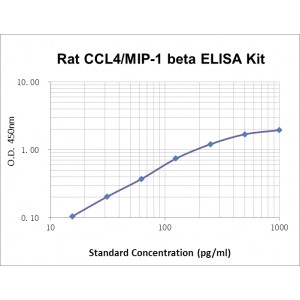More info
Assay Range | 15.6-1,000 pg/mL |
Sensitivity | 10.0 pg/mL |
Size | 96T |
Storage | Store at 2 - 8ºC. Keep reconstituted standard and detection Ab at -20 ºC |
Assay Principle | Sandwich ELISA |
Sample Volume | 100 µL final volume, dilution factor varies on samples |
Detection Method | Chromogenic |
Kit Components
1. Recombinant Rat CCL4 standard: 2 vials
2. One 96-well plate coated with anti- Rat CCL4 Ab
3. Sample diluent buffer: 12 mL - 1
4. Detection antibody: 130 µL, dilution 1:100
5. Streptavidin-HRP: 130 µL, dilution 1:100
6. Antibody diluent buffer: 12 mL x1
7. Streptavidin-HRP diluent buffer: 12 mL x1
8. TMB developing agent: 10 mL x1
9. Stop solution: 10 mL x1
10. Washing solution (20x): 25 mL x1
Background
Chemokine (C-C motif) ligand 4 (CCL4), also known as mcrophage inflammatory protein 1-beta (MIP-1-beta), G-26 T-lymphocyte-secreted protein, HC21, Lymphocyte activation gene 1 protein (LAG-1), is a protein encoded by the CCL4 gene in humans. Human CCL4 is synthesized as a 92 amino acid (aa) precursor protein with a 23 aa signal peptide and a 69 aa mature protein. The mature human CCL4 shares 70% aa with human MIP-1alpha. Human and mouse CCL4 show species cross-activity. Mature rat CCL4 shares 80% and 86% aa sequence identity with human and mouse CCL4, respectively.
CCL4 is secreted at sites of inflammation by activated leukocytes, lymphocytes, vascular endothelial cells, and pulmonary smooth muscle cells. CCL4 binds to the chemokine receptors CCR5 and CCR1, alternately termed MIP-1alpha/RANTES receptor, which also is a ligand for MIP-1alpha, RANTES, and MCP-1 with varying affinities. However, CCR1 does not transduce MIP-1beta signals. CCL4 functions as a chemoattractant in natural killer cells, monocytes and a variety of other immune cells. CCL4 attracts a variety of immune cells to sites of microbial infection as well as to other pathologic inflammation such as allergic asthma and ischemic myocardium. It also is a major HIV-suppressive factor produced by CD8+ T cells.


